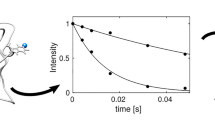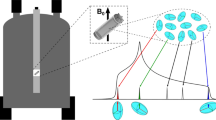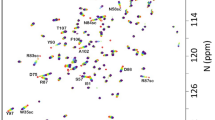Abstract
Protein interactions are important for understanding many molecular mechanisms underlying cellular processes. So far, interfaces between interacting proteins have been characterized by NMR spectroscopy mostly by using chemical shift perturbations and cross-saturation via intermolecular cross-relaxation. Although powerful, these techniques cannot provide unambiguous estimates of intermolecular distances between interacting proteins. Here, we present an alternative approach, called REDSPRINT (REDduced/Standard PRoton density INTerface identification), to map protein interfaces with greater accuracy by using multiple NMR probes. Our approach is based on monitoring the cross-relaxation from a source protein (or from an arbitrary ligand that need not be a protein) with high proton density to a target protein (or other biomolecule) with low proton density by using isotope-filtered nuclear Overhauser spectroscopy (NOESY). This methodology uses different isotropic labeling for the source and target proteins to identify the source-target interface and also determine the proton density of the source protein at the interface for protein-protein or protein-ligand docking. Simulation indicates significant gains in sensitivity because of the resultant relaxation properties, and the utility of this technique, including a method for direct determination of the protein interface, is demonstrated for two different protein–protein complexes.






Similar content being viewed by others
References
Bermejo GA, Llinás M (2008) Deuterated protein folds obtained directly from unassigned nuclear overhauser effect data. J Am Chem Soc 130:3797–3805
Bottini N, Musumeci L, Alonso A, Rahmouni S, Nika K, Rostamkhani M, Macmurray J, Meloni GF, Lucarelli P, Pellecchia M, Eisenbarth GS, Comings D, Mustelin T (2004) A functional variant of lymphoid tyrosine phosphatase is associated with type I diabetes. Nat Genet 36:337–338
Breeze AL (2000) Isotope-filtered NMR methods for the study of biomolecular structure and interactions. Prog NMR Spectrosc 36:323–372
Burz D, Dutta K, Cowburn D, Shekhtman A (2006a) In-cell NMR for protein-protein interactions (STINT-NMR). Nat Protoc 1:146–152
Burz D, Dutta K, Cowburn D, Shekhtman A (2006b) Mapping structural interactions using in-cell NMR spectroscopy (STINT-NMR). Nat Methods 3:91–93
Clore GM (2000) Accurate and rapid docking of protein-protein complexes on the basis of intermolecular nuclear overhauser enhancement data and dipolar couplings by rigid body minimization. Proc Natl Acad Sci USA 97:9021–9025
Cornilescu G, Marquardt JL, Ottiger M, Bax A (1998) Validation of protein structure from anisotropic carbonyl chemical shifts in a dilute liquid crystalline phase. J Amer Chem Soc 120:6836–6837
Das R, Andre I, Shen Y, Wu Y, Lemak A, Bansal S, Arrowsmith CH, Szyperski T, Baker D (2009) Simultaneous prediction of protein folding and docking at high resolution. Proc Natl Acad Sci USA 106:18978–18983
Delaglio F, Grzesiek S, Vuister GW, Zhu G, Pfeifer J, Bax A (1995) NMRPipe: a multidimensional spectral processing system based on UNIX pipes. J Biomol NMR 6:277–293
Dominguez C, Boelens R, Bonvin A (2003) HADDOCK: a protein-protein docking approach based on biochemical or biophysical information. J Am Chem Soc 125:1731–1737
Eichmuller C, Tollinger M, Krautler B, Konrat R (2001) Mapping the ligand binding site at protein side-chains in protein-ligand complexes through NOE difference spectroscopy. J Biomol NMR 20:195–202
Ferrage F, Zoonens M, Warschawski DE, Popot JL, Bodenhausen G (2003) Slow diffusion of macromolecular assemblies by a new pulsed field gradient NMR method. J Am Chem Soc 125:2541–2545
Ferrage F, Zoonens M, Warschawski DE, Popot JL, Bodenhausen G (2004) Slow diffusion of macromolecular assemblies measured by a new pulsed field gradient NMR method (vol 125, pg 2541, 2003). J Am Chem Soc 126:5654
Fiaux J, Bertelsen EB, Horwich AL, Wuthrich K (2002) NMR analysis of a 900 K GroEL GroES complex. Nature 418:207–211
Foster MP, Wuttke DS, Clemens KR, Jahnke W, Radhakrishnan I, Tennant L, Reymond M, Chung J, Wright PE (1998) Chemical shift as a probe of molecular interfaces: NMR studies of DNA binding by the three amino-terminal zinc finger domains from transcription factor IIIA. J Biomol NMR 12:51–71
Frueh DP, Ito T, Li JS, Wagner G, Glaser SJ, Khaneja N (2005) Sensitivity enhancement in NMR of macromolecules by application of optimal control theory. J Biomol NMR 32:23–30
Fushman D, Cowburn D (2003) Characterization of inter-domain orientations in solution using the NMR relaxation approach. In: Krishna NR, Berliner LJ (eds) Biological Magnetic Resonance. Kluwer Academic, New York, pp 53–77
Fushman D, Xu R, Cowburn D (1999) Direct determination of changes of interdomain orientation on ligation: use of the orientational dependence of 15N NMR relaxation in Abl SH(32). Biochemistry 38:10225–10230
Fushman D, Varadan R, Assfalg M, Walker O (2004) Determining domain orientation in macromolecules by using spin-relaxation and residual dipolar coupling measurements. Prog NMR Spectrosc 44:189–214
Gaponenko V, Altieri AS, Li J, Byrd RA (2002) Breaking symmetry in the structure determination of (large) symmetric protein dimers. J Biomol NMR 24:143–148
Gardner KH, Kay LE (1998) The use of 2H, 13C, 15N multidimensional NMR to study the structure and dynamics of proteins. Annu Rev Biophys Biomol Struct 27:357–406
Ghose R, Shekhtman A, Goger M, Ji H, Cowburn D (2001) A novel, specific interaction involving the Csk SH3 domain and its natural ligand. Nat Struct Biol 8:998–1004
Gross JD, Gelev VM, Wagner G (2003) A sensitive and robust method for obtaining intermolecular NOEs between side chains in large protein complexes. J Biomol NMR 25:235–242
Guiles RD, Sarma S, Digate RJ, Banville D, Basus VJ, Kuntz ID, Waskell L (1996) Pseudocontact shifts used in the restraint of the solution structures of electron transfer complexes. Nat Struct Biol 3:333–339
Hamel DJ, Dahlquist FW (2005) The contact interface of a 120 kD CheA-CheW complex by methyl TROSY interaction spectroscopy. J Am Chem Soc 127:9676–9677
Horst R, Fenton WA, Englander SW, Wuthrich K, Horwich AL (2007) Folding trajectories of human dihydrofolate reductase inside the GroEL GroES chaperonin cavity and free in solution. Proc Natl Acad Sci USA 104:20788–20792
Ikura M, Bax A (1992) Isotope-filtered 2D NMR of a protein-peptide complex: study of a skeletal muscule myosin light chain kinase fragment bound to calmodulin. J Am Chem Soc 114:2433–2440
Jayalakshmi V, Krishna NR (2002) Complete relaxation and conformational exchange matrix (CORCEMA) analysis of intermolecular saturation transfer effects in reversibly forming ligand-receptor complexes. J Mag Res 155:106–118
Johnson BA, Blevins RA (1994) NMRView: a computer program for the visualization and analysis of NMR data. J Biomol NMR 4:603–614
Kiihne SR, Creemers AF, De Grip WJ, Bovee-Geurts PH, Lugtenburg J, De Groot HJ (2005) Selective interface detection: mapping binding site contacts in membrane proteins by NMR spectroscopy. J Am Chem Soc 127:5734–5735
Kumar A, Ernst RR, Wüthrich K (1980) A two-dimensional nuclear Overhauser enhancement (2D NOE) experiment for the elucidation of complete proton-proton cross-relaxation networks in biological macromolecules. Biochem Biophys Res Comm 95:1–6
Macura S, Ernst RR (1980) Elucidation of cross relaxation in liquids by two-dimensional NMR-spectroscopy. Mol Phys 41:95–117
Matsuda T, Ikegami T, Nakajima N, Yamazaki T, Nakamura H (2004) Model building of a protein-protein complexed structure using saturation transfer and residual dipolar coupling without paired intermolecular NOE. J Biomol NMR 29:325–338
Muralidharan V, Dutta K, Cho J, Vila-Perello M, Raleigh DP, Cowburn D, Muir TW (2006) Solution structure and folding characteristics of the C-terminal SH3 domain of c-Crk-II. Biochemistry 45:8874–8884
Neuhaus D, Williamson MP (2000) The nuclear overhauser effect in structural and conformational analysis. John Wiley & Sons, New York
Ollerenshaw JE, Tugarinov V, Kay LE (2003) Methyl TROSY: explanation and experimental verification. Mag Res Chem 41:843–852
Otting G, Wuthrich K (1990) Heteronuclear filters in two-dimensional [1H, 1H]-NMR spectroscopy: combined use with isotope labelling for studies of macromolecular conformation and intermolecular interactions. Q Rev Biophys 23:39–96
Pintacuda G, Park AY, Keniry MA, Dixon NE, Otting G (2006) Lanthanide labeling offers fast NMR approach to 3D structure determinations of protein-protein complexes. J Am Chem Soc 128:3696–3702
Rain JC, Selig L, De Reuse H, Battaglia V, Reverdy C, Simon S, Lenzen G, Petel F, Wojcik J, Schachter V, Chemama Y, Labigne A, Legrain P (2001) The protein-protein interaction map of Helicobacter pylori. Nature 409:211–215
Ryabov Y, Fushman D (2007) Structural assembly of multidomain proteins and protein complexes guided by the overall rotational diffusion tensor. J Am Chem Soc 129:7894–7902
Shekhtman A, Ghose R, Goger M, Cowburn D (2002) NMR structure determination and investigation using a reduced proton (REDPRO) labeling strategy for proteins. FEBS Lett 524:177–182
Shimada I, Ueda T, Matsumoto M, Sakakura M, Osawa M, Takeuchi K, Nishida N, Takahashi H (2009) Cross-saturation and transferred cross-saturation experiments. Prog Nucl Magn Reson Spectrosc 54:123–140
Staley JP, Kim PS (1994) Formation of a native-like subdomain in a partially folded intermediate of bovine pancreatic trypsin inhibitor. Protein Sci 3:1822–1832
Sui XG, Xu YQ, Giovannelli JL, Ho NT, Ho C, Yang DW (2005) Mapping protein-protein interfaces on the basis of proton density difference. Ang Chem Int Ed 44:5141–5144
Swanson KA, Kang RS, Stamenova SD, Hicke L, Radhakrishnan I (2003) Solution structure of Vps27 UIM-ubiquitin complex important for endosomal sorting and receptor downregulation. EMBO J 22:4597–4606
Takahashi H, Nakanishi T, Kami K, Arata Y, Shimada I (2000) A novel NMR method for determining the interfaces of large protein-protein complexes. Nat Stru Biol 7:220–223
Takahashi H, Miyazawa M, Ina Y, Fukunishi Y, Mizukoshi Y, Nakamura H, Shimada I (2006) Utilization of methyl proton resonances in cross-saturation measurement for determining the interfaces of large protein-protein complexes. J Biomol NMR 34:167–177
Uetz P, Giot L, Cagney G, Mansfield TA, Judson RS, Knight JR, Lockshon D, Narayan V, Srinivasan M, Pochart P, Qureshi-Emili A, Li Y, Godwin B, Conover D, Kalbfleisch T, Vijayadamodar G, Yang M, Johnston M, Fields S, Rothberg JM (2000) A comprehensive analysis of protein-protein interactions in Saccharomyces cerevisiae. Nature 403:623–627
Van Dijk ADJ, Boelens R, Bonvin A (2005) Data-driven docking for the study of biomolecular complexes. FEBS J 272:293–312
Williams DC Jr, Cai M, Suh JY, Peterkofsky A, Clore GM (2005) Solution NMR structure of the 48-kDa IIαMannose-HPr complex of the Escherichia coli mannose phosphotransferase system. J Biol Chem 280:20775–20784
Wolff K, Vendruscolo M, Porto M (2008) Stochastic reconstruction of protein structures from effective connectivity profiles. PMC Biophys 1:5
Xu Y, Zheng Y, Fan J, Yang D (2006) A new strategy for structure determination of large proteins in solution without deuteration. Nat Meth 33:931–937
Yamazaki T, Forman-Kay JD, Kay LE (1993) 2-Dimensional NMR experiments for correlating 13Cβ and 1H-δ/ε chemical-shifts of aromatic residues in 13C-labeled proteins via scalar couplings. J Am Chem Soc 115:11054–11055
You J, Cohen RE, Pickart CM (1999) Construct for high-level expression and low misincorporation of lysine for arginine during expression of pET-encoded eukaryotic proteins in Escherichia coli. Biotechn 27:950–954
Zangger K, Oberer M, Keller W, Sterk H (2003) X-filtering for a range of coupling constants: application to the detection of intermolecular NOEs. J Mag Res 160:97–106
Zwahlen C, Legault P, Vincent SJF, Greenblatt J, Konrat R, Kay LE (1997) Methods for measurement of intermolecular NOEs by multinuclear NMR spectroscopy: application to a bacteriophage lambda N-peptide/boxB RNA complex. J Am Chem Soc 119:6711–6721
Acknowledgments
We thank Geoffrey Bodenhausen for his careful reading of a version of the manuscript. Supported by grant GM 47021 from the National Institute of Health. AS was supported by grant 1-06-CD-23 from the American Diabetes Association. FF thanks the French Ministry of Foreign Affairs for a Lavoisier fellowship.
Author information
Authors and Affiliations
Corresponding author
Electronic supplementary material
Rights and permissions
About this article
Cite this article
Ferrage, F., Dutta, K., Shekhtman, A. et al. Structural determination of biomolecular interfaces by nuclear magnetic resonance of proteins with reduced proton density. J Biomol NMR 47, 41–54 (2010). https://doi.org/10.1007/s10858-010-9409-9
Received:
Accepted:
Published:
Issue Date:
DOI: https://doi.org/10.1007/s10858-010-9409-9




